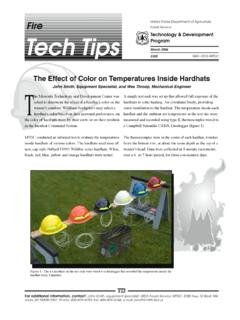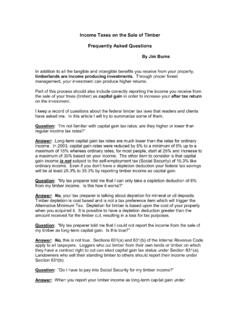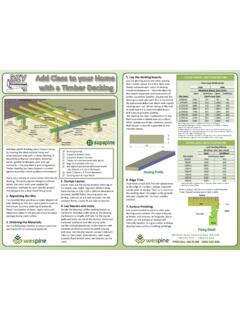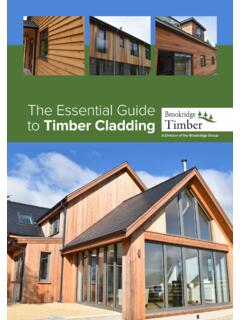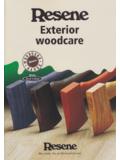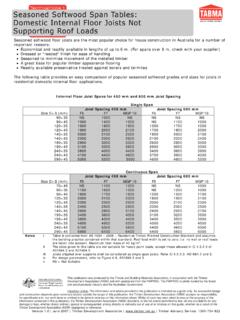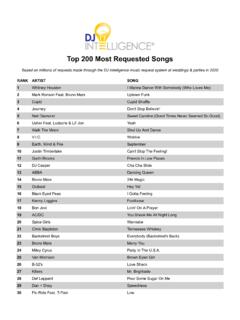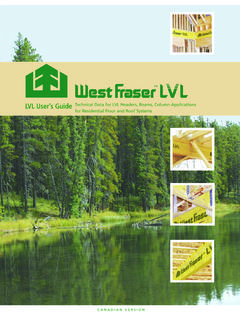Transcription of Federal Income Tax on Timber - US Forest Service
1 Federal Income Tax on Timber A Key to Your Most Frequently Asked Questions Harry L. Haney, Jr., Garland Gray Emeritus Professor of Forestry, Department of Forestry, Virginia Polytechnic Institute and State University, Blacksburg, Virginia William C. Siegel, Attorney and Forest Service Volunteer, River Ridge, Louisiana Larry M. Bishop, Forest Management and Taxation Specialist, USDA Forest Service , Southern Region, Atlanta, Georgia United States Department of Agriculture Forest Service Southern Region R8-TP 34 Revised December 2005 2 Introduction This publication examines the most common situations noncorporate taxpayers face when calculating Federal Income tax on their Timber holdings. It addresses aspects of each situation using a three-column format. The columns are: Type of Forest Activity, How to Qualify for Best Tax Treatment, and Reporting and Tax Forms.
2 The responses are necessarily brief, and taxpayers should consult the other sources of information listed at the end of this publication for a more comprehensive discussion of these issues. The major purpose of this publication is to provide taxpayers with a quick reference to the Internal Revenue Service (IRS) forms necessary when filing Federal Income tax returns for forestry-related activities. Nonetheless, each taxpayer must first determine whether he or she operates his or her Timber activities as an investment, a trade or business (hereafter referred to simply as business), or for personal use. The Internal Revenue Code (IRC) of 1986 and IRS regulations do not specifically define these categories. Nevertheless, investments and businesses must have a profit motive for management and operating expenses to be deductible. Profit for tax purposes occurs when Income from an investment or business exceeds the expenses in a given year.
3 Profit also includes the appreciation in value of assets. This concept is particularly relevant to Timber , which increases in value through physical growth and enhanced quality even though it may not be harvested for a period of years. In addition, a business must rise to a higher level than an investment, in terms of scope, regularity, and continuity of activities. Once the determination is made, the taxpayer must report Income and expenses in a consistent manner. 3 A Key to Your Most Frequently Asked Questions Page 1. Made a Timber Sale Capital gains or ordinary Income for investors .. 4 Capital gains or ordinary Income for a trade or business .. 5 Expenses of sale .. 6 Installment sales .. 7 2. Incurred a Capital Expense Capitalization and basis.
4 8 Reforestation Expenses o Reforestation 9 o Reforestation amortization .. 10 Depreciable assets .. 11 3. Incurred Forestry Operating, Management, and Protection Expenses Timber management expenses, property taxes, and interest (general).. 12 Timber trade or business in which you materially participate .. 13 Timber trade or business in which you do not materially participate .. 14 Investment .. 15 4. Received Cost-share Payment Included in Income .. 16 Excluded from Income .. 17 5. Incurred a Timber Loss or Realized an Involuntary Gain Casualty loss .. 18 Timber theft .. 19 Public condemnation .. 20 Gain from involuntary conversion .. 21 41. Made a Timber * Sale Capital gains or ordinary Income for investors * The term Timber " includes the parts of standing trees that could be used to manufacture lumber, pulpwood, veneer, poles, piling, crossties, chip-n-saw, and other wood products.
5 Also included are evergreen (conifer) trees aged 6 years or older when severed from their roots and sold for ornamental purposes; , Christmas trees. Type of Forest Activity Timber held as an investment (rather than as a business) is a capital asset. Generally, profits from the sale of investment Timber can be treated as a long-term capital gain. Long-term capital gain status is advantageous because it lowers tax liability; because self-employment taxes do not apply; and, whereas the offset of capital losses against ordinary Income is limited to $3,000 per tax year, capital losses can offset capital gains in the same tax year without limit. An additional advantage is discussed on p. 21, Gain from involuntary conversion. Generally, the maximum long-term capital gains tax rate for Timber is 15 percent (for taxpayers in the 10 or 15 percent ordinary Income tax brackets, the maximum long-term capital gains rate is 15 percent).
6 How to Qualify for Best Tax Treatment An investor may consider lump-sum Timber sale proceeds long-term capital gains when certain holding-period requirements have been met. For purchased Timber , the holding period is one year. Generally, no holding period applies to Timber received through inheritance. Special holding-period requirements apply to Timber received as a gift, depending on details of the transaction; but the beneficiary does not need to have held the Timber for longer than 1 year. Investors may also claim capital gains under a pay-as-cut contract (a Section 631(b) transaction) or by electing to treat the cutting as a sale (a Section 631(a) transaction). Reporting and Tax Forms Net capital gains from a lump-sum Timber sale are determined by deducting from the gross sale price (stumpage, or price of the standing Timber ) its adjusted basis, as well as any sale costs.
7 Adjusted basis is the original cost, inheritance value, or donor s basis (gift tax is included in some instances), as adjusted for subsequent transactions. Adjusted basis is discussed in more detail on p. 8 through 11. Lump-sum Timber sales for all investors are reported on Part III, Profit or Loss from Land and Timber Sales, of Form T ( Timber ), Forest Activities Schedule. They are also reported on the appropriate Schedule D, Capital Gains and Losses. See p. 5, for information about reporting Section 631 transactions. 51. Made a Timber * Sale Capital gains or ordinary Income for a trade or business * The term Timber includes the parts of standing trees that could be used to manufacture lumber, pulpwood, veneer, poles, piling, crossties, chip-n-saw, and other wood products. Also included are evergreen (conifer) trees aged 6 years or older when they are severed from their roots and sold for ornamental purposes, , Christmas trees.
8 Type of Forest Activity Proceeds from Timber held for use in your business, or which is sold to customers, as stumpage including Timber specified in a right-to-cut contract will qualify for long-term capital gains if both holding-period and method-of-disposal requirements are met. Disposal includes sales where the owner maintains an economic interest (pay-as-cut sales), sells outright (lump sum sales) or elects to treat the cutting as a sale. Sole proprietors and members of a partnership whose Timber holdings constitute a business may be required to pay self-employment tax on ordinary Income , but on capital gains they pay none. Generally, the maximum long-term capital gains rate for Timber is 15 percent (for taxpayers in the 10 or 15 percent ordinary Income tax brackets, the maximum long-term capital gains rate is 5 percent). How to Qualify for Best Tax Treatment Landowners holding Timber assets, or individuals or entities that have contracted to cut Timber as part of their business may generally qualify proceeds from Timber disposal as a long-term capital gain.
9 Holding-period requirements and capital gains rates apply (see p. 4, Capital gains or ordinary Income for investors). When Timber is cut by the owner, or his or her agent, rather than sold as stumpage, part of the proceeds also may be considered long-term capital gains, but only if he or she elects to treat the cutting as a sale and the holding period includes the first day of the owner s tax year. The part that may be considered a capital gain is the difference between the Timber s adjusted basis (see p. 12 through 15) and its fair market value as stumpage on the first day of the tax year when cut, less expenses directly associated with the cutting. Reporting and Tax Forms Net taxable gain is determined for Timber stumpage disposals (either lump sum or pay-as-cut) by deducting from gross receipts the adjusted-basis and sale costs. When the owner cuts Timber and elects to treat the cutting as a sale (a Section 631(a) transaction), net taxable gain is determined by deducting the adjusted basis (depletion allowance) from the fair market value of the standing Timber on the first day of the tax year in which the cut occurs.
10 All three types of Timber disposals are recorded on Part III, Profit or Loss From Land and Timber Sales, of Form T ( Timber ), Forest Activities Schedule. Net gains or losses are then reported on Form 4797, Sales of Business Property, and transferred to the appropriate Schedule D, Capital Gains and Losses. The election to treat the cutting as a sale under Section 631(a) is made on Part II, of Form T ( Timber ), Forest Activities Schedule. 61. Made a Timber * Sale Expenses of sale * The term Timber includes the parts of standing trees that could be used to manufacturer lumber, pulpwood, veneer, poles, piling, crossties, chip-n-saw, and other wood products. Also included are evergreen (conifer) trees aged 6 years or older when they are severed from their roots and sold for ornamental purposes, , Christmas trees. Type of Forest Activity Sale expenses include the costs of Timber cruising and marking, sale advertising, and log scaling.







